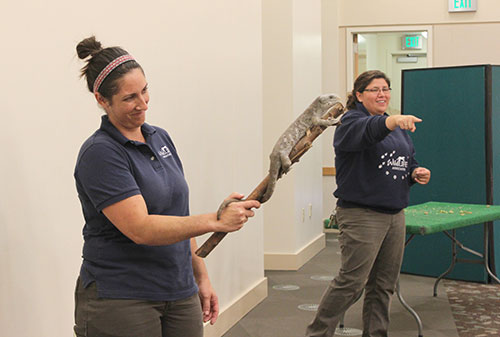
Have you tried bananas or chocolate?” educator and animal handler Reyanne Neal asked the children attending Wildlife Associates’ “Spirit of the Rainforest” presentation at Central Park Library on July 5. “These things come from the rainforest.”
Awareness of how everyday life connects with the lifecycles of faraway rainforests helps children understand the importance of preserving these threatened habitats and their interdependent plant and animal life. It’s estimated that half – or more – the world’s species live in rainforests and about a quarter of western pharmaceuticals are derived from compounds discovered in rainforests. A lot of water is stored in rainforest trees and plants, regulating the water cycle. Deforestation disrupts this ecosystem, destroying food sources and habitats for its animal dwellers, and increasing flooding, erosion and desertification.
Children attending the Spirit of the Rainforest” got to meet some of these rainforest animals.
“We’ve found that when we have programs that incorporate live animals, it’s a magical experience for the kids,” says Jenny Gregg, children’s librarian at Central Park Library. “Hopefully this program will help children develop a better compassion for animals,” she says, especially those living in endangered rainforests.
As Neal explained the four layers of a rainforest, she asked children to make corresponding hand motions. High above the ground is the emergent layer (bring up hands), next is the canopy layer (bring hands to the sides), then the understory (roll hands around) and finally, the forest floor (touch toes).
“From the emergent layer, we brought a bird named Rubio,” says Neal as Alison Rouhas, also an animal educator and handler, showed a bright red bird with yellow, green and blue accents on the tail. “He’s a scarlet macaw. He can say different words but he doesn’t know how to hold a conversation when he talks. He says what he has heard over and over again.”
A prickly-looking porcupine named Pig was the second animal the group got to see. Neal revealed the important role this animal from the rainforest’s canopy layer, plays in the ecosystem.
“As Pig poos, he will actually poop out the seeds of the fruits he ate,” Neal says. “You might think that’s gross but the seeds that he poops out help nourish the plants in the rainforest. It helps the rainforest stay healthy with new plant life.
Children also met Uncle Fester, a prehensile-tailed skink, typical of reptilian wildlife in the understory of a rainforest.
“He has short legs, long toes and sharp claws; that’s why he’s on a stick,” Neal says. “If Alison tried to hold him in her arms, she would get scratched.”
From the forest floor came a furry white anteater named George.
“Those big ears on his head are for hearing,” Neal says. “Stick your hands behind your ears and push them forward. Do I get louder or softer? I get louder. George’s ears are sticking out the way they are so he could listen for ants. It’s important to have anteaters around to make sure the ant population stays in balance.”
“Today’s program on animals interested me because the children get to meet live animals,” says Elena Semenova, whose child participated in the program.
“I liked the whole program,” says Sofia, 7. “I got to learn about how animals live in the rainforest.”
CAPTION: Although porcupines live in the rainforest canopy, their dietary habits are important to maintaining healthy plant live on the forest floor.





